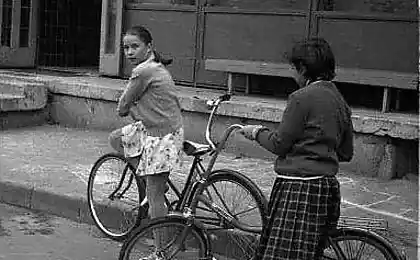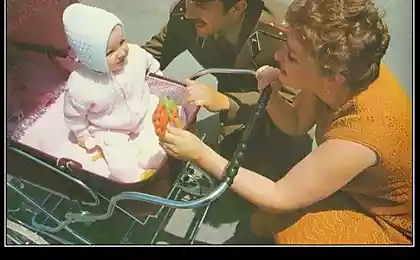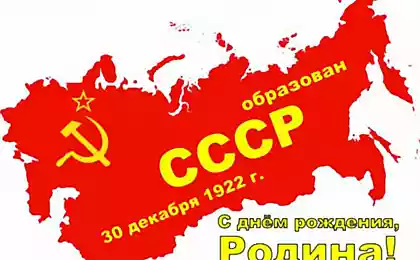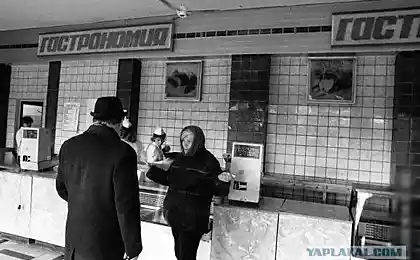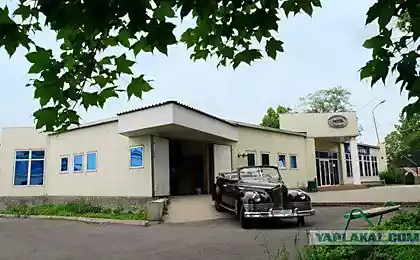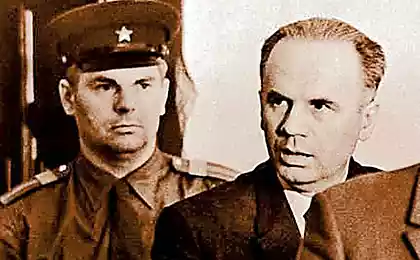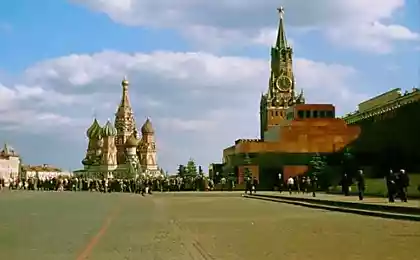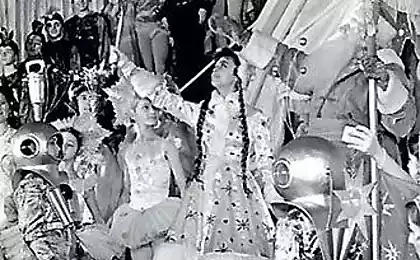1392
In the USSR, industrial design was!
Interview with Dmitry Azrikanom - one of those people who shaped the face of the Soviet 70-80gg design, built and created a profession shkolu.Znamenity Russian and American designer Dmitry Azrikan talks about his projects and design in the USSR of the sixties and the eighties of the twentieth century.
How did you come to this profession?
About the profession began to think much earlier than graduated from high school. It's funny, but I knew what I wanted to do, unaware of the possible existence of such a profession. Neither of which the design is naturally in those years in the USSR, one never heard of. Not that the word was unknown, was absolutely unimaginable scope of such activities. I thought I wanted to be a designer. I went to engineering technology. The choice was no longer anything else. And many first Soviet designers' 60s in the original were engineers.
The first years of the designer's work, as I now realize I was doing technical dissent, paying great attention to the form, ergonomics, everything that connects the product to the person. I was looked upon as a man not of this world, but we must pay tribute to my first superiors, not much disturbed.
And then in the 61 th came VNIITE. I rushed to Moscow, look what they're doing and immediately realized that I was, it turns out, the designer. A couple of years enrolled in graduate school VNIITE, and then moved back to work.
Then the design of the Soviet Union was the second hole in the Iron Curtain. The first was jazz. The youth cafe playing jazz, playing in VNIITE design. Especially gifted played in both places.

The recorder versatile, wearable and on-board, "Saiga". Group of samples marching direction (design program "Bamz"). 1986 g of. Em>

Detail design of the "electrometer", 1973-1979 years. em>
How are your idea of what "design" and the reality congruent and then?
Then there were two actually. One of VNIITE, the other for his windows. In VNIITE design was understood as a whole as well as in Europe, where he came from. Much later, the institute looked for domestic roots of this phenomenon, in what many have succeeded. On my same sense of design was greatly influenced by Larissa Zhadova article about Western designers - Mario Bellini, Ettore Sottsass, Roger Tallon and others. Dieter Rams, Thomas Maldonado, Achille Castiglioni, Joe Colombo - personified all the design so much that it seemed these people have their own design.
Outside, meanwhile, ran a completely different life. No, of course, "the consumer" in the design bylo.Obyvatel not the same, and for us this everyman-producer-consumers are usually the chief engineer of a plant or an official cupola, ministries and so on., Design perceived as a nuisance, imposed top nobody needs embellishment.

Fragments of the concept of long-term electronic equipment of dwellings, 1986 g of. em>

The television receiver "Crystal", 1988 em>.

console to a television receiver "Crystal", 1988 g of. em>
Does the object (s), you can call (without irony) a model of Soviet design?
There is such a thing!
It is a Soviet jet fighter late 40s, MiG-15, the hero of the Korean War. I MIG-15 adored. I painted it continuously. Once I made my way to asses the military airfield and drew him close, lying in the bushes, for which he received from noticing me from behind the barbed wire guard shot a flare gun. I now guess he missed. The aircraft was ideal proportions, extremely concise, elegant and expressive. He was very Soviet. In the course sense that Sovietness depicted by official propaganda. Almost like Mukhina pair of stainless steel.
The second is very Soviet in the same subject and not without relatives abroad was certainly the car "Victory". Too strong, pure, without superfluous details, the simple Soviet woman, something resembling cobblestone invincible proletariat. Or a girl with an oar out of the park culture. The old woman and now no matter where. Especially if as it is painted. Chocolate bottoms, coffee with milk from the top, and of course throughout the checkered board.

The design of the trains of the Moscow metro, 1987 g of. em>

Caravans 1988 g of. em>
What are the problems were solved designers in the Soviet Union, with almost no consumer market?
Instead, the market had a plan. Along with the plan to permanently shaken wise decisions on further enhancing the Party. The reason for the regulations were different incidents. For example, the American National Exhibition in 1959, the year in which Nixon in the exposure of American cuisine publicly shamed Khrushchev's why, they say, such a powerful country can not do a decent products for people to Khrushchev with his usual ingenuity, he promised to immediately bury capitalism, in order not to than it was compared. However, the kitchen was some kind of dispute to push to allow the design activity.
What is actually the problem solved by designers of the USSR in the period from Romanticism free policy design? There were different designers and different problems they solved. But there was something in common. I think not all even realize it. This general was, as it turned out a powerful protest potential of design. Regardless of the views of a particular designer his work objectively focused on exposure of anti-human nature of the system. Plates and layout designers quite clearly say: look, it turns out you can do it! What do you produce!

Mini-tractor "Cricket", 1989 g of. em>

The cable radio, 1988 g of. em>
A long list of projects of short heyday of my personal studio of the Union of Designers (from 1988 to 1992, the year) includes a number of small industrial dryer to a huge tractor. We get the prize of the international competition of office furniture in Spain in 1990 for a system of "Furnitroniks" - a hybrid of furniture and office electronics, where transparent panels for furniture boards are electronic networks and, thus, eliminate bunches of cables - trouble all computer jobs. This project was a manifesto of "design ties" that I came back in VNIITE. We received our first award in the currency, without the intervention of the party committees and other vermin. But it was still in the Soviet Union.


Electronic Office «Furnitronics», Prize International Competition in 1990 g of Spain. em>
Then - the prize of the international urban design competition in Nagoya, Japan, for the project "Flying Garden", in which the outer surface of the balloon, filled with helium, were living twined branches. Thus, we get a three-dimensional garden, which manages the configuration of the computer and to change depending on weather and time of day. On a hot afternoon garden served as a canopy in windy pressed to the ground, and in the evening formed a stage for concerts. Just by capricious distribution of helium balloons. It was very Japanese.
Then Kenji EQUAL invites me to become one of the focal points Interdesign "Living with Water" in Takaoka, Japan. And that's without the permission of any international departments VNIITE and the Committee on Science with terrible aunts in uniform blouse. Next - a personal exhibition of two Soviet designers Tanya and my Samoilova, AXIS Gallery in the bohemian district of Tokyo Roppongi.
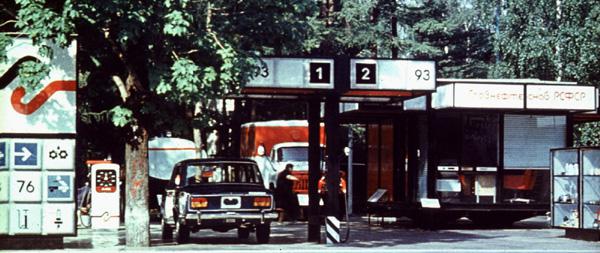
Gas Station, International exhibition "Car-73", Moscow, Sokolniki, 1973 em>

ticket office, 1989 g of. em>
In the early nineties, Dmitry Azrikan moved to the US.
via www.designet.ru/context/interview/?id=37621#allcomments
How did you come to this profession?
About the profession began to think much earlier than graduated from high school. It's funny, but I knew what I wanted to do, unaware of the possible existence of such a profession. Neither of which the design is naturally in those years in the USSR, one never heard of. Not that the word was unknown, was absolutely unimaginable scope of such activities. I thought I wanted to be a designer. I went to engineering technology. The choice was no longer anything else. And many first Soviet designers' 60s in the original were engineers.
The first years of the designer's work, as I now realize I was doing technical dissent, paying great attention to the form, ergonomics, everything that connects the product to the person. I was looked upon as a man not of this world, but we must pay tribute to my first superiors, not much disturbed.
And then in the 61 th came VNIITE. I rushed to Moscow, look what they're doing and immediately realized that I was, it turns out, the designer. A couple of years enrolled in graduate school VNIITE, and then moved back to work.
Then the design of the Soviet Union was the second hole in the Iron Curtain. The first was jazz. The youth cafe playing jazz, playing in VNIITE design. Especially gifted played in both places.

The recorder versatile, wearable and on-board, "Saiga". Group of samples marching direction (design program "Bamz"). 1986 g of. Em>

Detail design of the "electrometer", 1973-1979 years. em>
How are your idea of what "design" and the reality congruent and then?
Then there were two actually. One of VNIITE, the other for his windows. In VNIITE design was understood as a whole as well as in Europe, where he came from. Much later, the institute looked for domestic roots of this phenomenon, in what many have succeeded. On my same sense of design was greatly influenced by Larissa Zhadova article about Western designers - Mario Bellini, Ettore Sottsass, Roger Tallon and others. Dieter Rams, Thomas Maldonado, Achille Castiglioni, Joe Colombo - personified all the design so much that it seemed these people have their own design.
Outside, meanwhile, ran a completely different life. No, of course, "the consumer" in the design bylo.Obyvatel not the same, and for us this everyman-producer-consumers are usually the chief engineer of a plant or an official cupola, ministries and so on., Design perceived as a nuisance, imposed top nobody needs embellishment.

Fragments of the concept of long-term electronic equipment of dwellings, 1986 g of. em>

The television receiver "Crystal", 1988 em>.

console to a television receiver "Crystal", 1988 g of. em>
Does the object (s), you can call (without irony) a model of Soviet design?
There is such a thing!
It is a Soviet jet fighter late 40s, MiG-15, the hero of the Korean War. I MIG-15 adored. I painted it continuously. Once I made my way to asses the military airfield and drew him close, lying in the bushes, for which he received from noticing me from behind the barbed wire guard shot a flare gun. I now guess he missed. The aircraft was ideal proportions, extremely concise, elegant and expressive. He was very Soviet. In the course sense that Sovietness depicted by official propaganda. Almost like Mukhina pair of stainless steel.
The second is very Soviet in the same subject and not without relatives abroad was certainly the car "Victory". Too strong, pure, without superfluous details, the simple Soviet woman, something resembling cobblestone invincible proletariat. Or a girl with an oar out of the park culture. The old woman and now no matter where. Especially if as it is painted. Chocolate bottoms, coffee with milk from the top, and of course throughout the checkered board.

The design of the trains of the Moscow metro, 1987 g of. em>

Caravans 1988 g of. em>
What are the problems were solved designers in the Soviet Union, with almost no consumer market?
Instead, the market had a plan. Along with the plan to permanently shaken wise decisions on further enhancing the Party. The reason for the regulations were different incidents. For example, the American National Exhibition in 1959, the year in which Nixon in the exposure of American cuisine publicly shamed Khrushchev's why, they say, such a powerful country can not do a decent products for people to Khrushchev with his usual ingenuity, he promised to immediately bury capitalism, in order not to than it was compared. However, the kitchen was some kind of dispute to push to allow the design activity.
What is actually the problem solved by designers of the USSR in the period from Romanticism free policy design? There were different designers and different problems they solved. But there was something in common. I think not all even realize it. This general was, as it turned out a powerful protest potential of design. Regardless of the views of a particular designer his work objectively focused on exposure of anti-human nature of the system. Plates and layout designers quite clearly say: look, it turns out you can do it! What do you produce!

Mini-tractor "Cricket", 1989 g of. em>

The cable radio, 1988 g of. em>
A long list of projects of short heyday of my personal studio of the Union of Designers (from 1988 to 1992, the year) includes a number of small industrial dryer to a huge tractor. We get the prize of the international competition of office furniture in Spain in 1990 for a system of "Furnitroniks" - a hybrid of furniture and office electronics, where transparent panels for furniture boards are electronic networks and, thus, eliminate bunches of cables - trouble all computer jobs. This project was a manifesto of "design ties" that I came back in VNIITE. We received our first award in the currency, without the intervention of the party committees and other vermin. But it was still in the Soviet Union.


Electronic Office «Furnitronics», Prize International Competition in 1990 g of Spain. em>
Then - the prize of the international urban design competition in Nagoya, Japan, for the project "Flying Garden", in which the outer surface of the balloon, filled with helium, were living twined branches. Thus, we get a three-dimensional garden, which manages the configuration of the computer and to change depending on weather and time of day. On a hot afternoon garden served as a canopy in windy pressed to the ground, and in the evening formed a stage for concerts. Just by capricious distribution of helium balloons. It was very Japanese.
Then Kenji EQUAL invites me to become one of the focal points Interdesign "Living with Water" in Takaoka, Japan. And that's without the permission of any international departments VNIITE and the Committee on Science with terrible aunts in uniform blouse. Next - a personal exhibition of two Soviet designers Tanya and my Samoilova, AXIS Gallery in the bohemian district of Tokyo Roppongi.

Gas Station, International exhibition "Car-73", Moscow, Sokolniki, 1973 em>

ticket office, 1989 g of. em>
In the early nineties, Dmitry Azrikan moved to the US.
via www.designet.ru/context/interview/?id=37621#allcomments

